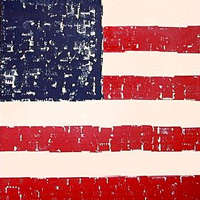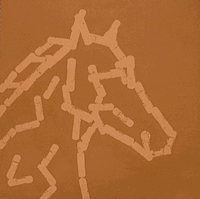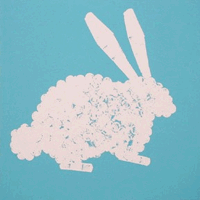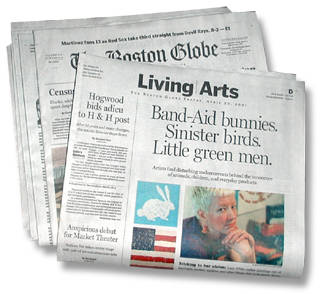| |
  At
her local drugstore, painter Lucy White is getting a reputation. At
her local drugstore, painter Lucy White is getting a reputation.
  "I
go to the store and buy tons of boxes of Band-Aids, and it's always
the same person at the counter," White says with a wry smile. "One
time, they asked, " 'Are you OK?' " "I
go to the store and buy tons of boxes of Band-Aids, and it's always
the same person at the counter," White says with a wry smile. "One
time, they asked, " 'Are you OK?' "
 White
explained that she was an artist, buying art supplies. White
explained that she was an artist, buying art supplies.
 "Oh, what kind
of artist?" asked the clerk. "Landscapes?" "Oh, what kind
of artist?" asked the clerk. "Landscapes?"
 Not exactly. White
told the fellow she painted with Band-Aids. She had been purchasing
more boxes of sanitary napkins than might seem, well, normal.
That's because she makes prints with them. Not exactly. White
told the fellow she painted with Band-Aids. She had been purchasing
more boxes of sanitary napkins than might seem, well, normal.
That's because she makes prints with them.
 The
clerk turned toward others in the line. "Next." The
clerk turned toward others in the line. "Next."
 Through April 28, White
is showing what she calls her "Band-Aid Paintings" at the
Bernard Toale Gallery. She makes them by coating paper with paint, then
affixing the bandages in the shape of, say, a bunny, a horse, or a gun.
She paints another layer of color, then removes the bandages leaving
a picture drawn in the clear, dimpled outlines of the bandages. Through April 28, White
is showing what she calls her "Band-Aid Paintings" at the
Bernard Toale Gallery. She makes them by coating paper with paint, then
affixing the bandages in the shape of, say, a bunny, a horse, or a gun.
She paints another layer of color, then removes the bandages leaving
a picture drawn in the clear, dimpled outlines of the bandages.
 "Technically,
I don't use the Band-Aids," White admits. "I use ones made
by 3M. They're called NexCare." "Technically,
I don't use the Band-Aids," White admits. "I use ones made
by 3M. They're called NexCare."
 Her "Kotex Diary"
prints are part of "Domestic Culture," a group exhibition
at the Institute of Contemporary Art at the Maine College of Art in
Portland. Her "Kotex Diary"
prints are part of "Domestic Culture," a group exhibition
at the Institute of Contemporary Art at the Maine College of Art in
Portland.
 "I'm actually
using Carefree and Lightdays," she confesses. "They're great.
The paper keeps absorbing and absorbing." "I'm actually
using Carefree and Lightdays," she confesses. "They're great.
The paper keeps absorbing and absorbing."
 Suspicious drugstore
clerks aside, White, 40, has developed a reputation as a hot young painter.
Her bandage painting "Flag," which is on display at the Toale
gallery, graces the cover of the New England edition of this year's
"New American Paintings" survey. Suspicious drugstore
clerks aside, White, 40, has developed a reputation as a hot young painter.
Her bandage painting "Flag," which is on display at the Toale
gallery, graces the cover of the New England edition of this year's
"New American Paintings" survey.
 The DeCordova Museum
has tapped her as part of next year's retrospective of 50 years of painting
in the region. The Maine Times declares White "arguably one of
the most important painters to come out of Maine in the last decade." The DeCordova Museum
has tapped her as part of next year's retrospective of 50 years of painting
in the region. The Maine Times declares White "arguably one of
the most important painters to come out of Maine in the last decade."
 She's a sprite of a
woman, with short, platinum blond hair. She moves around her North End
studio nervously, sipping a beer, trying to convey what it is she does,
but she is not quite at ease with her words. The studio, on the top
floor of an eight-story building, is orderly. But bright, puffy pompoms
are strewn across the floor. The artist put them there to distract from
the dust when the building held an open studios event. She's a sprite of a
woman, with short, platinum blond hair. She moves around her North End
studio nervously, sipping a beer, trying to convey what it is she does,
but she is not quite at ease with her words. The studio, on the top
floor of an eight-story building, is orderly. But bright, puffy pompoms
are strewn across the floor. The artist put them there to distract from
the dust when the building held an open studios event.
 For each new show,
White's artist statement begins the same way: "I grew up in Maine
in a house with a lawn, and a mother who took care of the house and
a father who took care of the lawn." For each new show,
White's artist statement begins the same way: "I grew up in Maine
in a house with a lawn, and a mother who took care of the house and
a father who took care of the lawn."
 The place was Brunswick,
Maine, overlooking Casco Bay. And suburban American identity is a frequent
subject of her work. The place was Brunswick,
Maine, overlooking Casco Bay. And suburban American identity is a frequent
subject of her work.
 White's last show featured
bandage paintings of houses: ranch houses, Colonials, Capes. The basic
lines of the bandage drawings convey a 1950s idealism, but the material
also speaks of wounds and simplistic solutions to harrowing problems.
There's the suggestion that maybe Beaver Cleaver had a few skeletons
in his closet. White's last show featured
bandage paintings of houses: ranch houses, Colonials, Capes. The basic
lines of the bandage drawings convey a 1950s idealism, but the material
also speaks of wounds and simplistic solutions to harrowing problems.
There's the suggestion that maybe Beaver Cleaver had a few skeletons
in his closet.
 "The work is not
100 percent autobiographical," White states. "It's like writing
fiction. I take some things from my life, but I change things around,
too. But people relate. A lot of people see the work, and say, 'Oh,
this was my childhood.' " "The work is not
100 percent autobiographical," White states. "It's like writing
fiction. I take some things from my life, but I change things around,
too. But people relate. A lot of people see the work, and say, 'Oh,
this was my childhood.' "
 She titles her works
with the brand name most associated with the product she uses —
such as Band-Aids and Kotex — because she sees humor and horror
in what those products have come to represent in American culture: society's
emphasis on cleanliness and disposability, as seen through the lens
of commerce. Whether the customer truly needs Band-Aids is not the point;
the market convinces of the need. "There's something superficial
about the product," White declares. "We never had Band-Aids
in the house when I was growing up, and my father was a pediatrician.
I think of them as being an all-American product." She titles her works
with the brand name most associated with the product she uses —
such as Band-Aids and Kotex — because she sees humor and horror
in what those products have come to represent in American culture: society's
emphasis on cleanliness and disposability, as seen through the lens
of commerce. Whether the customer truly needs Band-Aids is not the point;
the market convinces of the need. "There's something superficial
about the product," White declares. "We never had Band-Aids
in the house when I was growing up, and my father was a pediatrician.
I think of them as being an all-American product."
 Alongside tamer subjects,
the current Toale gallery show offers images of sex and violence. A
gun, a beer, a female torso, and a bat, make up one suite of paintings.
Lately, White has been churning out Band-Aid drawings, which she makes
more quickly than the paintings. In the drawings, she leaves the bandages
affixed to the paper. She favors decorative Band-Aids, and has made
a gun drawing with brightly colored Barbie Band-Aids. Alongside tamer subjects,
the current Toale gallery show offers images of sex and violence. A
gun, a beer, a female torso, and a bat, make up one suite of paintings.
Lately, White has been churning out Band-Aid drawings, which she makes
more quickly than the paintings. In the drawings, she leaves the bandages
affixed to the paper. She favors decorative Band-Aids, and has made
a gun drawing with brightly colored Barbie Band-Aids.
 The artist has come
a long way from the work she was doing back in 1993, when the Rose Art
Museum showed her Minimalist works, rectangular paintings with natural
forms like leaves, pods, and bugs embedded in layers of resin and sectioned
off in grid or diamond patterns. The artist has come
a long way from the work she was doing back in 1993, when the Rose Art
Museum showed her Minimalist works, rectangular paintings with natural
forms like leaves, pods, and bugs embedded in layers of resin and sectioned
off in grid or diamond patterns.
 "The older pieces
were about sitting, and meditating and being still," White says. "The older pieces
were about sitting, and meditating and being still," White says.
 She glances at the
newer works, with their bright colors and pop images, with their Band-Aids
and Kotex and Hand-Wipes, and smiles. "I guess I did kind of cut
loose," she says. She glances at the
newer works, with their bright colors and pop images, with their Band-Aids
and Kotex and Hand-Wipes, and smiles. "I guess I did kind of cut
loose," she says.
 What's next for White?
Her work on the Band-Aid drawings — which feature text for the
first time — has been "relentless," so she has enough
art for another solo show immediately. She just put up a Web site (www.lucywhite.com)
and hopes it will help market her art. What's next for White?
Her work on the Band-Aid drawings — which feature text for the
first time — has been "relentless," so she has enough
art for another solo show immediately. She just put up a Web site (www.lucywhite.com)
and hopes it will help market her art.
 Meanwhile, she already
has a new idea on the drawing board. Meanwhile, she already
has a new idea on the drawing board.
 White smiles. "I'm
making some Kraft macaroni and cheese paintings" White smiles. "I'm
making some Kraft macaroni and cheese paintings"
•••
<<
home
|
|

 The
Maine Times declares her "arguably one of the most
important artists to come out of Maine in the last
decade."
The
Maine Times declares her "arguably one of the most
important artists to come out of Maine in the last
decade."
  |
|



